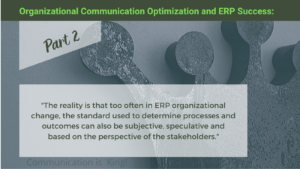 Value of objective measurement via communication optimization:
Value of objective measurement via communication optimization:
Communication optimization is king. ERP Implementation success demands objective measurement. The objective standard to measure a successful ERP implementation is determined and benchmarked by clearly identifying key performance indicators (KPIs) prior to and after implementation go-live. Clearly identified, communicated, measured, and monitored KPIs help provide the organization with “proof in the pudding” that the organizational outcomes are being met (see “Successful ERP Common Denominator: Definition and Vision of ERP Success“). This process to determine objective and thorough standards of measurement requires 1) an optimized and formal communication process and 2) adequate and appropriate stakeholder participation. Organizations should seek to achieve successful ERP organizational change with success being demonstrated by meeting specific and agreed upon corporate outcomes and results. Optimized, formal, and adequate stakeholder communication ensures alignment of outcomes and desired results. This is a critical first step in ERP organizational change as the appropriate goals and objectives should be benchmarked before, during, and after ERP organizational change.
Non-value of subjective and speculative measurement:
The reality is also that too often in ERP organizational change, the “standard” used to determine as well as measure the desired outcomes can be subjective, speculative, and based on the perspective of stakeholders. This issue then is that without optimized and formal communication, ERP implementation success can now mean many different things to many different people. There are multiple levels of stakeholders in private equity-owned portfolios that include for instance: investors, PE firm, executive team, subject matter experts/implementation team (internal and external), middle management, and workforce team. Influence upon and among these different strata of stakeholders comes in many ways. The relationships and roles of each level are important to understand because it helps explain the challenges of organizational change as well as organizational communication. As Lewis (2011) states, the challenge is that goals are likely to be held differently by different stakeholders and that goals within stakeholder groups are dynamic and can change over time. This provides a challenge in organizational change and communication because stakeholders are essentially able to rewrite history and also persuade themselves, and others, that the real goals (the current goals) existed from the onset of the project (Lewis, 2011). This can be a significant challenge.
Tactical action:
Research suggests that all too often, the process of determining objective measurement is given little value if it is measured at all. In addition, research shows that a lack of stakeholder communication leads to inadequate goal setting and measurement. Organizational goals and expected outcomes need to be set and established by a steering committee team consisting of an adequate representation of each stakeholder group. Through effective communication, this cross selection of stakeholders helps to manage and address stakeholder politics, ensure monitoring and feedback of appropriate and desired outcomes, acts as a coordination apparatus to resolve stakeholder group differences and can assist in addressing any disparities in diversity (knowledge, value, purpose, motivation, skill, experience) between stakeholder groups. Fui‐Hoon, Lee‐Shang, and Kuang (2001) state that “Because ERP systems are about integrating different business functions, interdepartmental communication and collaboration within the project team was found to be the core process for project progress. Presence and attitudes of the surrounding stakeholders, ie top management, project management, project champion, and software vendor, were identified as the root causes driving performance of this core process”.
The value of communication optimization in ERP implementation success is well understood. The key is to integrate sound communication practice into an ERP organizational change project plan. It is critical that ERP organizational change plans include a formal organizational communication method for ensuring that the strategic business goals and metrics are appropriate. And, that these metrics are used to further drive communication, progress, and action within every stakeholder group of the organization. Your ERP implementation success absolutely requires sound organizational communication.
Learn more:
Here is an interesting link by Matthew Koschmann “Part 1 of 4: What is Organizational Communication?”. a professor in the Department of Communication at the University of Colorado Boulder. The purpose is to explore the topic of collaboration and explain a constitutive communication approach to enhance our understanding of collaboration: https://youtu.be/iN_A7keXtVg
About Nestell & Associates: ERP Implementation Success
